MMCC OM#3284 | Raddic's Roughnecks | run by @soulventure91
Don't wanna be here? Send us removal request.
Text


friendly psa to CROP THAT MANDO!!! 💥💫
#mandalorian armor#beskar'gam#verp is CORRECT u WEAR THE CROPTOPS#(hilariously my fixlist needed me to add a plate that added a couple inches so there IS apparently a limit to the crop)
90 notes
·
View notes
Text
Just, mandos having wildly different ideals and morals, mandos having different versions of the Resol’nare, mandos having different traditions for the same events, mandos having different dialects of mando'a, some resembling more archaic versions of it and some mixing with the already existing languages of other planets into new whole vocabularies, mandos having different superstitions about the same animals/actions/objects/etc., mandos having different religions or just different versions of the same religion, mandos with many other jobs outside of mercenary or bounty hunter or field medic, mandos being so different from each other but still both being mandalorians in their own different ways-
178 notes
·
View notes
Text


Order 66: A Republic Commando Novel
195 notes
·
View notes
Text
Mandalorian Armor, a simple guide
Oh dear. Several months late, but here we go. This will be a broad term overview of mando armor in canon at the moment, not an exhaustive list. Feel free to skip “materials & history” if you’d just like some more concrete guidelines and refs!
(Remember to click on the images for a better look!)
Material & History
A Small Intro Course
Mandalorian armor is supposed to be made out of beskar, an alloy (and yes all beskar is an alloy in disney canon (at least as of May 2021), like steel for example. Yes even “pure” beskar). The secrets of how to make it is limited to the Mandalorians, and the materials used to make it are most likely limited to Mandalore or the Mandalore system. It’s been in confirmed use as an armor material for at least 900 years & can take straight blaster bolts or hold off the circulating energy blade of a lightsaber for short periods of time, possibly until the beskar heats up enough to loose its integrity, but the heat would most likely cause serious damage to the wearers body before that.
Beskar armor is most often inherited, passed from generation to generation and reforged to suit the current wearers needs. It’s seen as passing down the history, the battles and the will of those who have worn it before and making it your own. However the material is rare, possibly because the mines have run dry ages ago (old EU), or because war and/or the New Mandalorians stopping production. The Empire interfering by taking over Mandalore and trying to get their hands on as much beskar as possibly and then later “glassing” the planet while hunting its only known creators surely did not help either, in any case.
This means that not all Mandalorians had access to the material, or at least large enough amounts to make a full suit of armor. This lead to the make of “impure” beskar that can take less of a brunt & armor made of other metals such as durasteel. This is most likely what makes up the majority of Din’s kit, beyond the helmet and possibly the chest piece, when he’s introduced in S1 and he still wears pieces that might be one of these materials as of Season 2.
Characters like Sabine Wren, Bo-Katan Kryze and Boba Fett all inherited their armor from their aliit (clan/family) through several generations and it’s most likely already pure beskar based on its age and how it reacts to blasterfire.
The armor is most often painted and there are various designs and colors that indicate personality, achievements or allegiances, but that would have to be another post. (Would anyone like a post on Mandalorian armor fashion? Because I have thoughts)
Helmet
Let’s start from the top. The helmet, aka the bucket. The buy’ce.
In the “modern” era it’s usually a helmet with a rounded top and some kind of cheek indents. It has a T (or occasionally closer to a Y) shaped visor that obscures the wearers face. It also contains a large amount of technology that allows for various visual filters, binoculars, built in comms and audio enhancers (allowing for near perfect 360° hearing in the old EU, as possibly shown by Din Djarin in the new), among other things. The earcaps seen on most modern styles of helmet allows for various specialized attachments, like rangefinders.
The styles of the helmets vary between clans and eras, but there’s a few distinct modern bases that are pretty easy to identify as Mandalorian and worn by all major Mandalorian characters.
The Boba Fett, based on the original helmet as seen in the OT, and worn by basically every male character with various types of cheek indents, ridges and the like. Some are thinner or longer, but the base of the design is still very clearly the OG Boba Fett helmet. T visor, sharp slope indent that takes up the entire cheek, long ear caps & a brow ridge.
Visual Reference

The Nite Owl, based on the helmet worn by Bo-Katan and the Nite Owls in TCW. It has a cat eyed Y visor and a more of a cut out cheek indent style, or simply a less severe smaller curve under the visor ridge (the area painted red on Boba Fett’s helmet).
Visual Reference

The Kast, is the rarest so far only seen on Rook Kast & the Maul-aligned female Mandalorians. It slopes slightly inwards below the uniquely shaped T visor and has no ear caps.
Visual References

And finally, some mandalorian helmets with slightly more unique shapes and/or shape combinations that put them outside the general easy to identify pile.
From left to right, The Armorer, Paz Vizsla, Pre Vizsla and Fenn Rau:

Chest, Neck, Back & Shoulders
As with everything else, there are various styles for these pieces of armor, but here are some basics.
Breastplate
Most commonly visibly segmented into three big parts, two on the chest and one below, with a small diamond shaped heart piece in the middle. The heart piece design can also been seen on Mandalorian clothing and architecture. In The Mandalorian these parts are generally attached together to give the armor a more solid look, but they are still distinguishable. Before the fall of the empire several female mandos favoured a more solid two part design that interlocked with their neck piece and had a thin rectangular bar instead of a classic heart piece. During the clone wars women of the faction supporting Maul (mostly clan Kast and clan Saxon) used a semi-connected two part design with six smaller pieces trailing down the stomach, three on each side. There are also various other designs with solid one part chest pieces, but most at least have a variation of the heart piece in the middle, as seen on Paz Vizsla.
The chest piece usually does not go below the navel, for bending over reasons.
Neckplate
Either two pieces on the side of the neck, or a longer single piece that goes in front of the neck & sits over the collarbones. Both of these variations are usually semi connected to, or line up with where the backplate ends.
Shoulders
Bell type, like Din Djarin & Axe Woves wear. The Classic, aka the style worn by Boba Fett, Ursa Wren & most grunts. And finally a slightly rounded middle ground, smaller than the Bell but sits over the shoulder and is often favored by female characters like Bo-Katan, female Mauldalorians & Sabine Wren.
Backplate
Usually as long as the chest piece, used to protect the back and to mount jetpacks, and other useful things, on.
Jetpack
Technically not a piece of armor, but sometimes armored. Comes in various sizes and styles.
Visual References
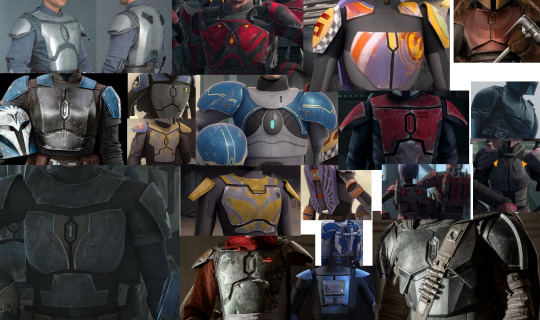
Vambraces & Handplates
Vambraces
Both forearm protection and weapons. Developed to give a Mandalorian that extra edge when fighting stronger opponents. To that goal, they’re often fitted with various attachments such as flamethrowers, retractable blades, shield emitters, repulsors, grappling lines, magnets, missiles and various types of darts, including the whistling birds seen in The Mandalorian.
Handplates
It’s a plate that goes on your hand. Nothing more, nothing less. Can of course be fitted with various other weapons, as long as they fit.
Visual References

The Codpiece, Buttplate & Hip Plates
Ah yes. Well.
All pieces are usually worn tucked underneath and/or attached to the waist sash/girth belt/belt.
Codpiece
Look, it’s a codpiece. It’s there to protect your sensitive parts. There are less bulky variations for people who can do without the extra space. Those are often segmented. Some wear more of a lower stomach plate. Others don’t bother, or only wear theirs when they might need it since I imagine it can be a bit uncomfortable to wear day to day.
Buttplate
It’s a plate that goes over your butt. And I mean just above, not on. Din has one, Boba has one. It’s a thing. Why? Because bruising you tailbone hurts like hell.
Hip Plates
They’re plates that go on your hips. Only confirmed sighting has been on Din, but we’ve also got some good shots of them because of this so I put them in anyway.
Visual References
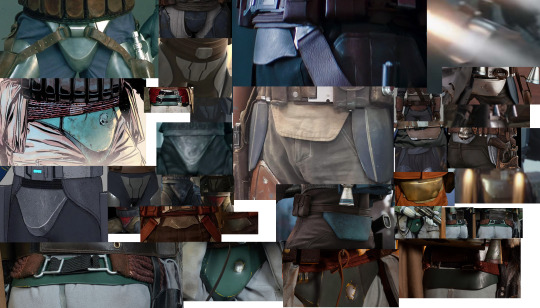
Thighs, Knees, Shins, Ankles & Feet
Varies from completely covered to almost no armor at all. On one end you’ve got Jango Fett, and on the other you’ve got Boba Fett. Ironic, in a way.
Thigh plates
Generally sit either on the front of the thigh or on the outer sides. The outward style thigh plates are more form fitting and allow for holsters to be mounted directly onto the plate, this was popular during the Clone Wars era. The front facing plates are often different sizes, possibly depending on your dominant hand/how you prefer to hold your weapon of choice.
Knee armor/pads
For knee protection, unless you’re like Boba Fett, then they’re also dart launchers. In the old EU the darts were laced with neurotoxin, but that seems to have been removed for new canon. Sit nebulously in the knee region.
Shin, Ankle and/or Boot plates
Over your shins, ankles and feet, for all your literal ass kicking needs. Comes in various types including but not limited to: boot caps, ankle plates, shin guards and of course full on greaves.
Visual References

-
So there you have it! A broad overview of Mandalorian armor. This has been in my drafts for months at this point so I’m not going to go over this again so you’ll have to excuse any weird phrasing or misspelt words. And how messy the visual ref sheets got. (I’m also considering putting together something for different eras & allegiances based on design, accessories, paintjobs, etc, but that will have to be another day.)
(Also, feel free to tag me or @ me or whatever on your art! I love seeing the different ways people design their mandos!)
5K notes
·
View notes
Text
AYOOOOOOOOOOOOOOOOOO I'M APPROVED!!!!! Still pending my official OM number but I am IN \o/

#star wars#mandalorian mercs#mando mercs#cosplay#mandalorian#aaaaaaaaaaaaaaaa so excitedddddd :3#now to enjoy this kit before i start chewing on a second lmaooooo
25 notes
·
View notes
Text
28 years ago my all-time-favorite Boba Fett quote was conceived.

586 notes
·
View notes
Text
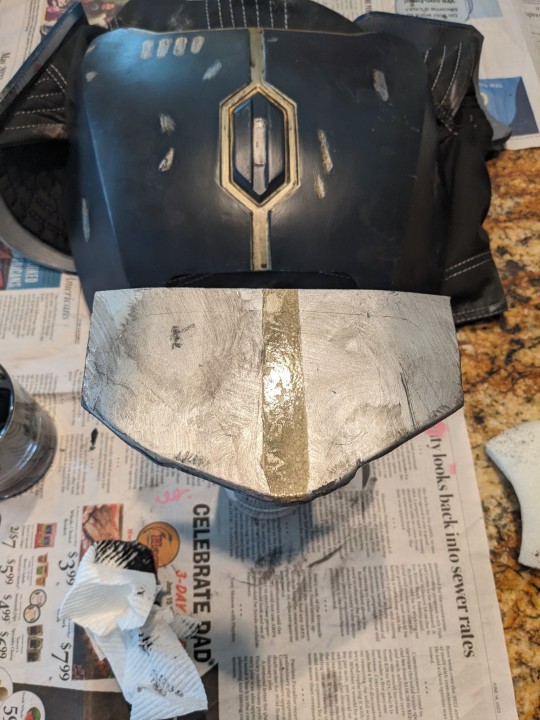
Ab plate PAINTED. It looks rough on intention along the bottom edge because of a long life of taking blasterfire and vibroblade cuts! Going to get it attached soon! Just glad I got the bronze stripe lined up neatly!
3 notes
·
View notes
Text
lo’kaan
Lit. “into war”
“unto the breach”, let’s try once more, “break a leg”. Contraction of "lo akaan", from an ancient epic*, with the famous line: "Sol'tugyc lo akaan, vod'e, tugyc...", "Once more unto the breach, dear friends, once more..."
* The ancient epic is, of course, Shakespeare's Henry V and the line is the first line of King Henry's speech. I unabashedly stole it.
30 notes
·
View notes
Text
whispers softly idk why people still insist mandalorians would think white = purity … there is absolutely no basis for this belief or color association whatsoever, and is clearly one that’s from biases of our world with no in-universe support, while mandalorians would be more likely to imply the opposite, or imply it sarcastically because purity as a concept is not something mandalorians would respect
… stop this, fandom. stop it.
1K notes
·
View notes
Text




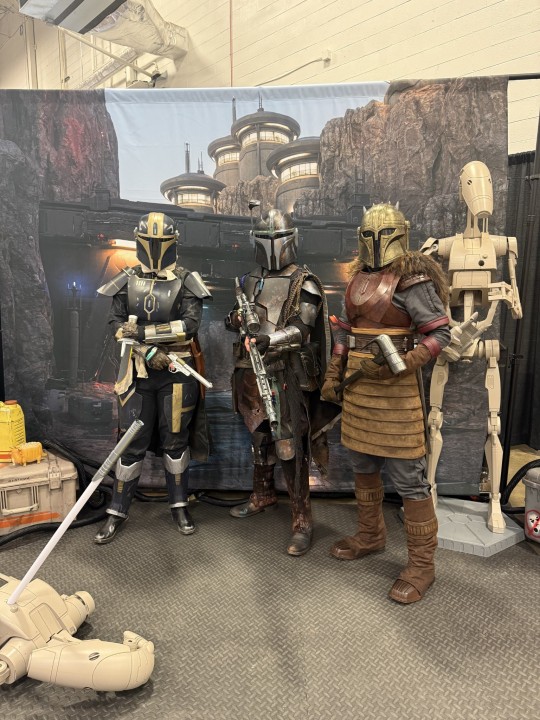
First con (Big Lick CC in NoVA) in full kit, alongside clanmates Vale and Yvie! Still waiting on hearing from the app team, so doing this private as a test run!
Kit wore super well; didn't bring any of my extras, and although I had to take my helmet off a couple times for hair maintenance. The con had really good ventilation and circulation too, so I never got overheated :D Nothing fell off or apart, and no crashes or weird contacts.
3 notes
·
View notes
Text


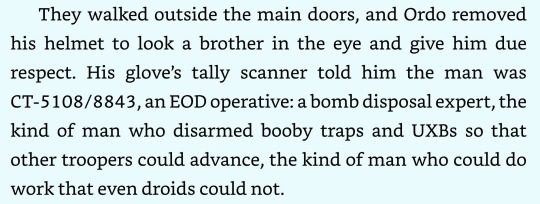



CLONE TROOPER LORE OF THE DAY: ARMOR TALLIES
Sources: The Complete Star Wars Encyclopedia by Stephen J. Sansweet and Pablo Hidalgo, Republic Commando, Star Wars: The Clone Wars (Movie Novelization)
409 notes
·
View notes
Text
It's app tiiiime!!
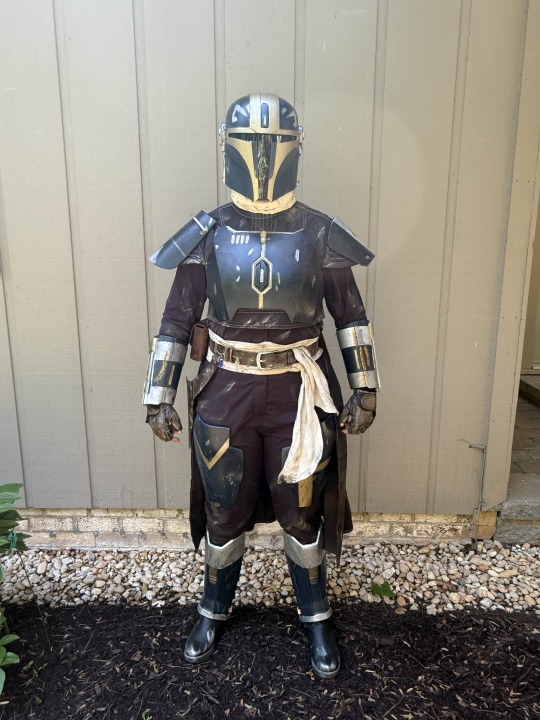






Plus some soft goods weathering details thanks to Ruus Vale's skilled handiwork and sharp eye!






Application goes in soon! Wish me luck!!
8 notes
·
View notes
Text
Boba Fett concept art






from the Empire Strikes Back Sketchbook by Joe Johnston and Nilo Rodis-Jamero
78 notes
·
View notes
Text
All right, per the fix list we've got some extra weathering!!



Starting with some subtle black acrylic dry-brushed onto chest and shoulders to try and help age these plates to match more with the back plate! Hard to see here but hopefully enough to have that aging nicely.



Followed up with black dry-brush on some parts of my helmet and "gunking" up the ear caps and back vent!




The biggest adjustment is some extra blackening and damage on the vambraces!
All in all this should help with the weathering of all plates looking more unified!!
3 notes
·
View notes
Text
Kyrimorut
I’ve just done another reread/skim of the repcomm books for details of Kyrimorut for @ossidae-passeridae, who encouraged me to do a write up for reference. Some of these facts are explicitly stated, scattered throughout the series, and some are my own surmises. (My main conclusion is that KT considered architecture just about as carefully as the TCW creators did the GAR ranking system. lolsob)
So. In this essay I will
Kyrimorut, Kal Skirata’s refuge for his clone sons, was called a bastion, and frequently described in siege terms. It was also referred to as a homestead and a farmhouse.
“It was yaim—part barracks, part hotel, part married quarters, part farmhouse, the archetypal Mandalorian clan home.”
This stronghold was located in the heavily forested northern hemisphere of the planet Mandalore, a few hours flight north of Keldabe City, within 100 kilometers of a small town called Enceri, and just south of a lake. It boasted a main house and numerous outbuildings, including at least one medical laboratory, animal pens, and a hangar large enough for multiple craft.
Rav Bralor, another of the Cuy’val Dar, rebuilt it at Kal’s request during the war, and it was finished enough by a year in, to house some members of their group temporarily, but was still undergoing renovations up to the last moment before they moved in. She used droids to aid in the construction. The building was composed of brick, wood, stone, and rammed earth, and the (probably local, veshok) planks were joined with interlocking joints. The interior walls were plastered and painted, likely with naturally derived mineral paints; one room was mentioned to be “honey-colored.” The windows were narrow, described as arrow-slits, and the doors were unpowered hinged wooden slabs. The whole thing was large, and the rooms were characterized as airy and roomy at various points.
The layout seems to have been vaguely circular, or a circle of chained hubs, with a central karyai. The lobby was another hub, and there were both surface and underground passages connecting the hubs, radiating out like “the spokes of an eccentric wheel.” For this reason I think there were two floors in the main house with one above, the other underground. There was also a sheltered circular atrium off the main hub, with a roof that slid back, where they roasted meat.
The house had gutters and down-pipes to deal with snowmelt and rain, and given the nearby lake, they would have to have a good vapor barrier for the underground portion. Since the place was rural rather than urban, it was largely quiet, and the homestead's acoustics were such that sound carried well. This indicates to me that likely only the exterior walls were fortified of heavy stone and rammed earth; interior walls were more likely built of wood and plaster and easier to modify if they had some need. Power was unreliable in such a remote setting, so they used wood fires for heating and cooking; everything smelled of wood-smoke. The entire structure was designed to be unnoticeable from the air, and the clearing was not visible until the last moment upon aerial approach.
The karyai was the main living room. In one scene, Kad played on the floor with toy animals (nerf, bantha, shatual, nuna, jackrab, vhe’viin) Atin had carved from veshok wood, Wade Tay’haai played a purple-painted bes’bev (sharp flute), and Rav Bralor brought throat-searing tihaar for everyone. She lived on her own clan’s farm a few kilometers away, and had brought Yayax squad, who mostly stayed there, to visit Kyrimorut. They were learning carpentry from manuals, as one does.
People had their own rooms for sleeping, with couples sharing, along the corridors. Arla and Uthan’s rooms both had exterior windows. Quarters were pleasant, plain but comfortable, with generous mattresses on the beds and a table for personal use.
Then there was a room Etain thought of as the interrogation room, so that’s uhhh lovely.
It’s unclear whether the large table where they gathered for communal meals was in the karyai, the kitchen (which was separated from other areas by a door), or some other room. Wherever it was located, it was possible for someone seated at the table to lean back without getting up and fetch a bottle of tihaar from where it was stored. The table was made of a single large slab of veshok wood, and was big and sturdy enough to use for surgical operation, dismantling engines, or seating a whole clan of armored Mandalorians. They sat in chairs around this table, and Kad sat in a highchair. They used porceplast plates, and mugs for ne’tra gal, a sweet black beer. The head of the household summoned everyone to the table for meals.
The kitchen contained a fireplace and hearth, a chair (where Kal slept), ovens and stovetops, a conservator, enough workspace for at least four people at once, and an adjoining storage area. The kitchen could be a busy, noisy, bustling place, but it was separate from other living areas; people sometimes went there to avoid others.
The 20-30 occupants ate constantly and prodigiously, and never seemed to be lacking. The food was described as filling but not elegant, and was heavy on the protein. They consumed a lot of game; Lord Mirdalan the strill was an animal native to Mandalore and a hunter. Roast shatual, nerf, and roba were mentioned, and they would leave a joint of meat on the table to be eaten all day down to the bone (I shuddered in food hygiene). Fish from the lake were fried in a pan, and they made broth from gihaal, dried smoked fish with a pungent aroma stored in metal containers, one of the staples of Mandalorian ration packs because it kept for years without refrigeration. Also what Kal called Kaminoans, but that’s another story!
We were worried they only ate meat for a while until we came across some vegetables. Kad had pureed kaneta at one point, and for breakfast boiled grain porridge and shirred eggs were on offer. Jilka diced amber root for some dish. Mealbread rolls were also plentiful, and there was a vat of stew at one point. Listed imports via Ny Vollen included flour, grassgrain, pickles, powdered milk, sacks of denta beans, soap, dried fruit, and a bantha bone which was hard to get on Mandalore. The roba they raised themselves.
The roba pen had multiple animals witht at least one boar and one sow with a litter, and despite having veshok posts and walls, the gate was left open. I’m extrapolating that these animals were semi-domesticated and allowed to forage for food but came home to their pen for safety at night. There were rail fences, crop fields, and plans for raising nerf on the property as well. Outbuildings were mentioned frequently, but this was one of the few actually described.
Notable native species mentioned were the large, ancient veshok trees, which were evergreen, hardwood, and straight enough that the table slab was cut out of one large piece. They were ice-glazed and dripping in the spring thaw, so presumably had some defenses against freezing and exploding, or breaking under the weight of the ice, and they populated all the way up to the the polar cap. There was underbrush and bushes, and groundthorn weed, which was very stubborn and difficult to remove entirely. The roba would have helped with uprooting this as they foraged. Vhe’viine were small rodents with white winter coats that lived in burrows in the fields.
The medical laboratory behind the main house (it was necessary to walk around the bastion after exiting to approach it) was a mobile genetics lab/agricultural trailer of the sort usually used for breeding livestock and at racetracks. It was occupied first by Ko Sai and later by Ovolot Qail Uthan. Mereel acquired it, and Mij Gilamar stocked it with stolen/black market medical equipment. When Uthan took over, they built her more lab space. There were rural veterinarians in the community as well; Etain mentioned getting a cryocontainer for a sample from a neighboring farm.
The hangar was situated in a shallow slope to the north of the main house, half-buried in the soil and disguised with netting. It was large enough to house several craft at a time, including Ny Vollen’s ship, Mereel’s speeder, and the Aay’han, among others. Swabbing down the compartments of the Aay’han, replenishing stores, and prepping the ship for the next flight managed to occupy most of an afternoon for four men.
The lake was also to the north, and I believe it was a very large lake, functioning as a heat-sink. It had not fully frozen despite the bitter winter, described as minus eight and thirty degrees colder than tropical (although the temperature scale is not mentioned, it’s likely celsius because of the author’s background). There was ice extending from the shore like a pier, but also mist rising above it in the early morning and frost on the shore, even though layers of snow deep enough for feet to crunch through the surface were mentioned elsewhere at various times. This led my friend to speculate that there could be geothermal activity in/under that lake. Kal and Walon Vau were planning to build a memorial on the near lake shore featuring the armor tallies of fallen clone soldiers.
There was granite in the area, which also gave support to the concept of historical volcanic activity. Their yard sported four chunks, each large enough for at least two people to climb up and perch upon, which had erupted from the surface long ago and been worn down to a weathered polish. Winds came in off a nearby plain. A clear (muddy) area large enough to play mesh’geroya was also near the house.
Enceri had at least one cantina, there was a landmark grain silo at the edge of town, and it was big enough to host a bustling market square, despite being described as more of a trading post than a town. There they could buy, among other things, preserved vegetables, engine parts, and local triple-distilled tihaar, which could double as degreaser for said engine parts.
If they needed more than Enceri had to offer, they could go south to Keldabe. Landmarks of note there included the River Kelita and the Oyu’baat tavern. The Imperial garrison was located near Keldabe.
“But then Mandalore itself was one big contradiction, with heavy industry and shipbuilding sitting cheek-by-jowl with farms that hadn't changed in centuries, sophisticated electronics and ancient metalworking skills side-by-side in the same suit of armor.”
Established clan homes seem to be the usual way of things despite Mandalorians supposedly being nomadic. Their “temporary” structures being wattle and daub also indicates the nomad thing to be a bit of a fallacy. Even so, they had planned a possible relocation for Kyrimorut in the worst case, a bolt-hole on Cheravh. Jaing had taken to calling it offsite hot standby.
So that’s Kyrimorut, which means Final Haven, where Kal Skirata and his chosen family hunkered down in the aftermath of Order 66. My friend says it’s basically Aberdeen, down to the detail of players getting plastered mid footie limmie game. I gathered these details from four books (Hard Contact does not mention Kyrimorut) and compiled them for anyone who’d like to make use of the rundown. Oya!
108 notes
·
View notes
Text
Good news!! Fix list is in and fairly minor!! Mostly subjective weathering levels on my back and leg llates, as well as the expected "please weather and address paint weirdness on your vambraces" and "please weather your soft goods okok" nods. Ruus Vale says this can be handled at AP on the 17th so I'm juuuust gonna chill!
(I am not chill aaaaaaaa)
2 notes
·
View notes
Text
Been reading @blackkatmagic’s as wild wings follow. I love the Mandalorian worldbuilding there, especially the funeral road and funerary field. And as one thought led to another…
I do think Mandalorians would be big on parades, actually. But they would think of them as ceremonial marches (along certain traditional or ceremonial routes/roads)—solemn occasions of reenacting/remembering past events, or carrying the deceased on their last march. So they’re not supposed to be displays of might and glory (although some certainly would have done that too, especially in the times of the Mandalorian empire).
As I understand it, reenactors have already adopted the practice. Clearly there’s something that resonates.
#can confirm! kyrimorut conducted our second death march in honor of those we lost this year at awesomecon#it may not be a “canon” tradition but it feels right and it fits the culture well#mandalorians#mando musings
22 notes
·
View notes